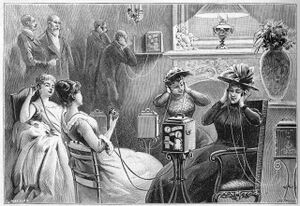Home Theatre
The théâtrophone system allowed subscribers to listen to opera and theatre performances over the telephone. First demonstrated in Paris in 1881, the system was later commercialised by Compagnie du Théâtrophone, operating until 1932.
The origin of the théâtrophone (Q15905) can be traced to a telephonic transmission system demonstrated by Clément Adler at the 1881 International Exposition of Electricity in Paris to allow broadcasting of concerts or plays. Adler had arranged 80 telephone transmitters across the front of a stage to create a form of stereophonic sound. It was the first two-channel audio system, and consisted of a series of telephone transmitters connected from the stage of the Paris Opera to a suite of rooms at the Paris Electrical Exhibition, where the visitors could hear performances in stereo using two earpieces; the Opera was located more than two kilometres away from the venue.
The théâtrophone technology was made available in Belgium in 1884, and in Lisbon in 1885. In Sweden, the first telephone transmission of an opera performance took place in Stockholm in May 1887. In 1890, the system became operational as a commercial service in Paris, offered by Compagnie du Théâtrophone, which was founded by MM. Marinovitch and Szarvady. The service can be called a prototype of the telephone newspaper, as it included five-minute news programs at regular intervals.
The Théâtrophone Company set up coin-operated telephone receivers in hotels, cafés, clubs, and other locations, costing 50 centimes for five minutes of listening. Subscription tickets were issued at a reduced rate, to attract regular patrons. The service was also available to home subscribers. Many technological improvements were made to the original théâtrophone system during the time it was in operation. The théâtrophone finally succumbed to the rising popularity of radio broadcasting and the phonograph, and the Compagnie du Théâtrophone ceased its operations in 1932. Similar systems existed elsewhere in Europe included Telefon Hírmondó (established in 1893) of Budapest and Electrophone of London (established in 1895).
The idea for this early form of streaming and online services, as offered more recently by theatres closed due to the Covid19 pandemic, was created by giving each consumer two earpieces: one microphone on the left and one on the right side of the stage offered stereo reproduction. So, the ladies and gentlemen in evening dress stood in front of silent walls and listened spellbound until the roaring final applause, which roared in their ears as a violent storm, as one ear witness indicated with fright. The initially rather imperfect system was refined over the years. For example, care had to be taken that the percussion instruments and brass players did not stand too close to the microphones; also, the gas lights installed in all the theatres still disturbed the microphones considerably through their draught and the refraction of sound due to their heat. In addition, transmission by specially laid cable was very expensive: the first live broadcasts therefore took place in public rooms, in cafés or salons.
Although they still had a rather cumbersome appearance, the devices were portable and soon found their way into the households of upmarket Parisian society. It was fashionable not to be seen in the foyer of the opera house but to listen to the sounds and voices in the comfort of one’s own home, but this had its price: the annual user fee was 180 francs, and another 15 francs had to be paid per performance. Nevertheless, by the end of the 19th century, there were already 1300 subscribers in Paris. To ensure the smooth running of the business, telephone operators were hired to find music lovers instead of people to talk to.
One of the subscribers from 1911 was Marcel Proust. The bedridden man had his theatre phone within reach, paid his fee and suddenly found himself in the middle of the Opéra Comique, the Comédie-Française, the Châtelet, the Théâtre des Variétés, or the Théâtre des Nouveautés. The writer (like the majority of subscribers in general) preferred operas to plays, concerts or variety performances. Addressing Madame Straus in March 1913, Proust became sentimental: “Have you subscribed to the Théâtrophone? They now bring the ‘Concerts Touche’, and I can be visited in my bed by the brooks and the birds of the ‘Pastoral Symphony’, which poor Beethoven could no more enjoy directly than I could […]. Far from genius and without talent, I make pastoral symphonies in my own way, by depicting what I can no longer see.”


